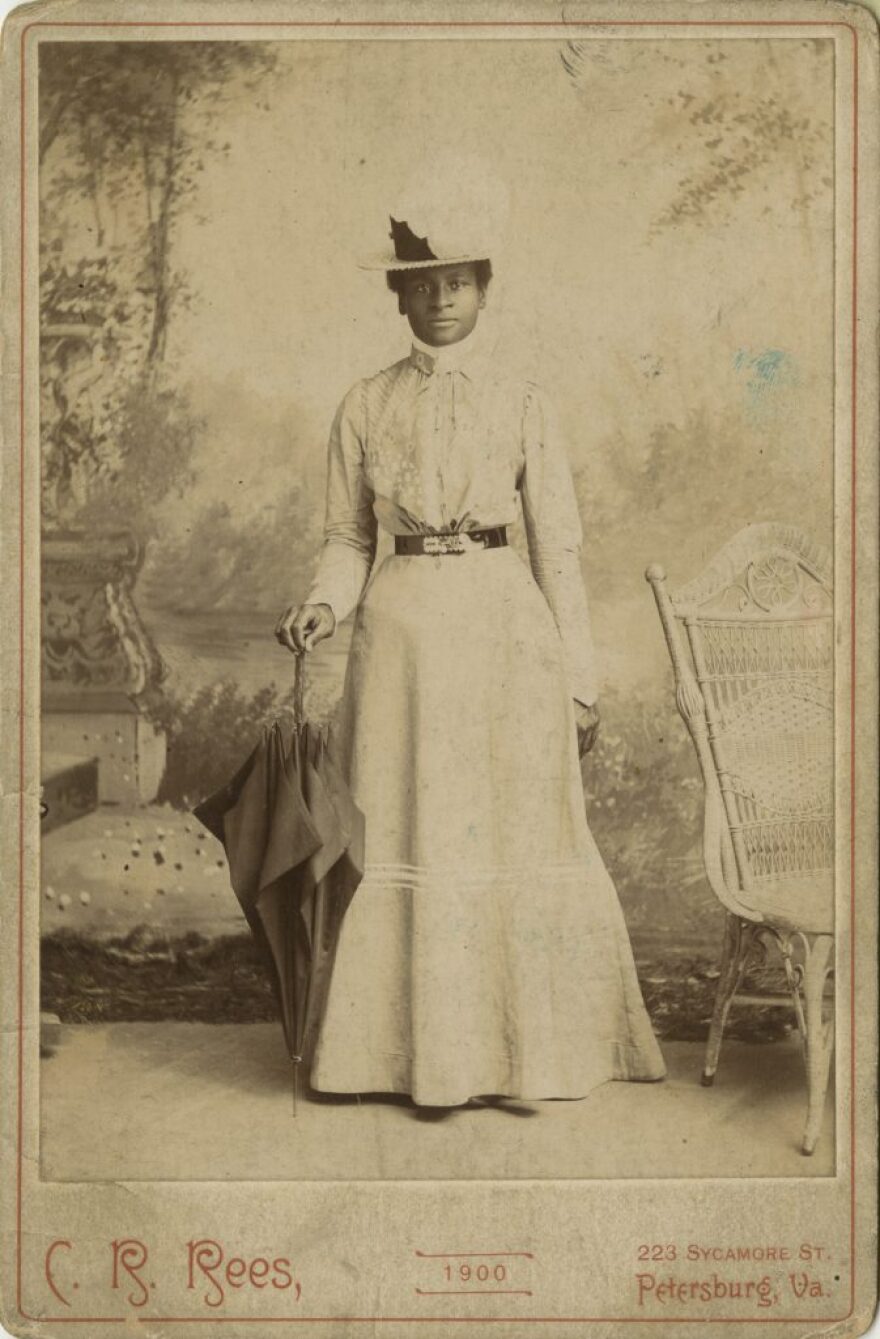Gov. Ralph Northam’s administration recently announced the state would add five new highway markers. Selected from student submitted suggestions, the new markers will tell the story of notable Black Virginians.
Included in the new additions are Dangerfield and Harriet Newby, John L. Whitehead, Edwin B. Henderson, Samuel P. Bolling and former Richmonder Mary Richards Bowser.
Mary was enslaved at birth by the Van Lew family, who held as many as 21 people in slavery. Elizbeth Van Lew, the family’s daughter who went by Bet, held anti-slavery sentiments however, and arranged for Mary to be educated, later sending her to live in Liberia.
“It was not unusual for white enslavers to not be quite comfortable owning slaves but also not quite understand or envision a place for free Black people as full citizens in the United States,” said Lois Leveen, a historian working on a biography of Mary’s life.
She says Mary was miserable during her time in Liberia, eventually convincing Van Lew to let her return to the U.S. And it was back in Richmond where Mary cemented her place in the historic record.
The story often repeated about Mary is that during the Civil War, she posed as a slave in the Confederate White House, spying on men such as Confederate President Jefferson Davis and covertly slipping intelligence to Van Lew.
“[It’s] a story that Americans love. One person succeeded against all the odds, and it’s got this great multicultural twist because now our hero is a woman of color,” Leveen said. “We love an individualistic narrative, but the truth is that that’s not really how most historical change happens.”
She says Mary was, in fact, part of an interracial, underground group which worked to undermine the Confederacy, by helping prisoners escape from the Confederate capital and smuggling information out of the Confederate White House.
In her research, Leveen says she’s also found evidence Mary infiltrated both the Confederate White House and Senate. But focusing the narrative solely on Mary could leave out the stories of other Black Virginians and the full history of the Richmond Underground.
“As exciting as it is that she’s going to be given this historical marker, we don’t want the historical marker to kinda reify this idea that there’s this one great person who makes history,” she said.

Jen Loux, who runs the state’s highway marker program, says that sort of thinking is built right into the program’s statement of purpose.
“Markers are not in the same category as monuments or memorial plaques,” she said. “They're not intended to honor their subjects, they’re intended to educate the public.”
Virginia’s highway marker program is the oldest in the nation, with the first placed on Route 1 in 1927, and has grown to over 2,600 markers. But Loux says the state has reissued some older plaques, starting in the 1990s.
“As you can imagine with a program that began in the 1920s, by the ‘90s there were a number of markers out there that had language that was no longer acceptable and offensive,” she said.
And, she adds, many of them excluded the stories of Black and indigenous Virginians. One such marker told the story of Poplar Forest, Thomas Jefferson’s plantation in Bedford County, without mention of the hundreds of Black people Jefferson held in slavery at the site. The marker was updated in 2017.
As of January 2020, only 350 historical markers highlighted the role of Black Virginians in the commonwealth’s history. But Loux said over the last five years, nearly half of new markers have been focused of African American history.
“It’s dangerous to not incorporate everyone into the historical narrative, because that leaves us with a distorted understanding in the present of why things are the way they are now and how they came to be,” she said. “It’s crucial that a program as visible and as public as the state marker program do its very best to tell the full story of Virginia history.”
For years, advocates have been calling on southern states to reevaluate monuments and markers, seeking a more inclusive telling of history. Holly Pinheiro, a history professor at Augusta University, says these calls get at a fundamental truth of southern history.
“African Americans, Native Americans have been here, and it’s about time there are markers to remember the ways in which they’ve always been there,” he said.
Between 1618 and 1620, Portugal invaded the Kingdom of Ndongo in what is now Angola. The Portuguese invaders captured thousands of people from Ndongo, shipping them into enslavement in the Americas.
On one such journey, English sailors attacked a ship carrying 350 enslaved people and kidnapped 60 who survived the attack. In August, 1619, those survivors became the first enslaved Virginians.
Over the more than 200 years that followed, slavery became a major industry. In 1860, Virginians enslaved nearly 500,000 people, more than were bonded in any other state. But Pinheiro says the magnitude of slavery is often understated.
“Even when I was a student at Virginian schools, I did not get the deep understanding of bondage even though I had family members who were enslaved,” he said. “To not know what my ancestors experienced, or when it was talked about it was in a very passing manner, that makes me as a student, as a Virginian, feel that I don’t matter.”
Even when Black Americans were included in the historical record, they’re often tacked on to stories about white Americans, Leveen says. That’s true for Mary.
“Her story was often originally circulated to add color, and I use that term advisedly, to stories that were really about Bet Van Lew,” Leveen said.
Mary’s name first became widely known around 1910, when a reporter interviewed the niece of Bet Van Lew, who had died in 1900. The niece told the reporter that though she had been young at the time, she remembered the name of a spy in the Confederate White House as Mary Elizabeth Bowser.
Except, Leveen says, Mary didn’t go by Bowser. Instead, the name comes from a brief, and likely unhappy, marriage with an enslaved man named Wilson Bowser. The marriage ended before the war was over.
Mary was married at least twice more, taking several names throughout her life, according to Leveen. She adds name changes were common in the 19th century for both women and the formerly enslaved, who often changed their names after they attained freedom.
“She’s kinda going through both of those things. As a Black person wanting to choose how she’s identified, not how other people identify her, [and] as a woman when she is moving in and out of relationships,” Leveen said. “But there’s another level here, because of course her work in the Richmond underground during the war depends on her being able to hide in plain sight.”
After the war, Mary continued to be “cagey” about her name, worried about attracting attention. But that didn’t stop her from advocating and fighting for racial justice, Leveen says.
Mary founded schools for and taught the newly emancipated in Virginia, Florida and Georgia. While still teaching, she wrote letters to government officials urging them to protect the safety and civil rights of Black Americans. But her activism wasn’t limited to letter writing.
“She publicly speaks out about racial profiling by the police in Savannah during reconstruction, for which she’s immediately arrested. She’s assaulted while in police custody,” Leveen said.
In the original announcement of Mary’s marker, she’s referred to as “Mary Richards Bowser.” There is no mention of her post-war, anti-racist activism outside of a cursory mention of her work at freedman’s schools. Leveen says she would change that.
“I would probably not use the last name Bowser. It was not a name that she chose to identify by,” she said. “She used many different surnames throughout her life, but the ones she used most often were Richards during the war and then later in life Denman. So I would refer to her as Mary Richards Denman.
“I would also emphasize that her activism continued after the war. She gave public lectures in the north in which she demands equal rights for African Americans… She identified as a member of women’s rights organizations and other political organizations. She documented acts of white supremacist violence.”
Loux says the announcement text will not be on the final marker, adding that the Department of Historic Resources, which runs the marker program with the Department of Transportation, will conduct its own research before proposing marker text.
“These signs are very visible to the public. Our goal, our entire purpose for being is to educate the public about important people, places and events in Virginia history,” she said. “The markers appear very authoritative. They have the state seal on them, so if we’re going to put that seal of approval on them, we want to be certain that what we’re putting out there is accurate.”
The five new markers are expected to be approved at a June 17 meeting of the Board of Historical Resources.
Editor’s note: Throughout this piece, we refer to Mary Richards Denman as “Mary.” While we usually use subjects’ last names, to avoid confusion around the several names Mary used throughout her life, we chose to use her first name.
Correction: We've made one update to a sentence describing Wilson Bowser; an earlier version of this story said he was enslaved by the same family as Mary. The historical record is not clear on that connection, so we've removed it.



